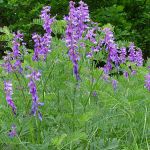| Common Name: |
Siberian Milkwort |
| Botanical Name: |
Polygala tenuifolia |
| Genus: |
Polygala |
| Family: |
Polygalaceae |
| Native Location: |
Siberia, Mongolia, and China |
| Cultivation: |
Well-drained, moisture-retentive soil in sun or part shade. |
| Propagation: |
By seed sown in autumn. |
| Harvest: |
Roots are lifted in autumn and dried for use in decoctions, concentrated infusions, liquid extracts, powders and tinctures. |
| Height: |
25cm (10in) |
| Width: |
25cm (10in) |
| Hardiness: |
Z4-8 |
| Parts Used: |
Roots (yuan zhi) |
| Properties: |
A pungent, bitter, warming herb that lowers blood pressure and has expectorant, anti-bacterial, and tranquilizing effects. It acts mainly as a tonic for heart and kidney energies. |
| Medicinal Uses: |
Internally for coughs with profuse phlegm, bronchitis, insomnia, palpitations, poor memory, anxiety, depression, and nervous tension. Externally for boils and carbuncles. Combined with Glycyrrhiza uralensis (See, Chinese Licorice) for coughs in heavy smokers. |
| Bibliography: |
Encyclopedia of Herbs by Deni Brown Copyright © 1995, 2001 Dorling Kindersley Limites. Pg 326
|

